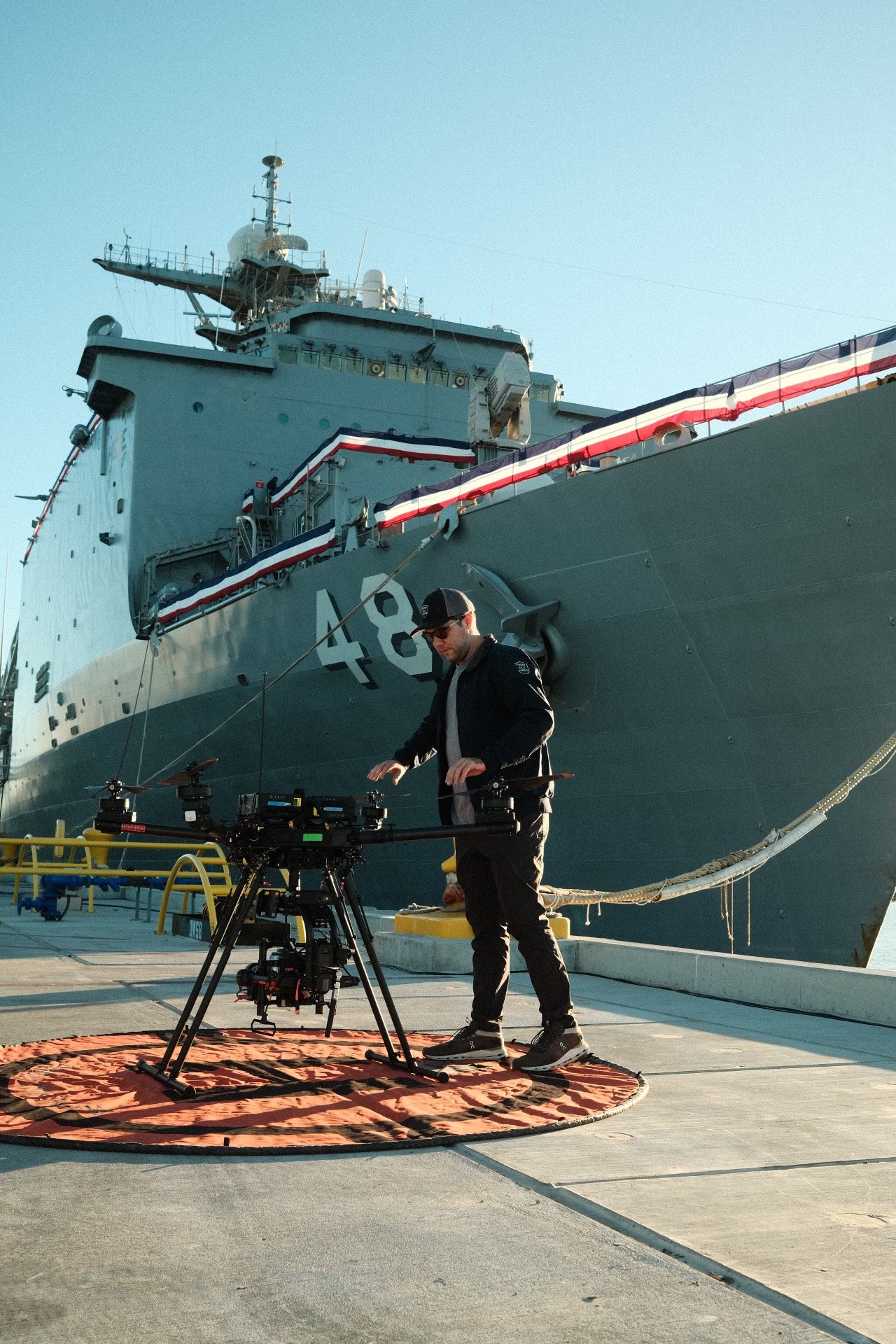The Rising Influence of Drones in Broadcast Production
A decade after their introduction, broadcasters get more creative

From more than 200 feet off the ground outside of L.A.’s iconic Dodger Stadium, a camera gives viewers of Game 5 of the World Series a charming mood shot of the stadium’s exterior to accompany a break in the action. Sports fans have seen similar shots a million times over the years, right? Not like this.
On this night, the shot begins to track into the venue as the camera, attached to a remotely piloted drone, soars between the flagpoles atop the stadium’s main entrance and then rises into the sky, revealing a breathtaking view of the Los Angeles skyline amid the stunning glow of a lavender sunset. Visuals like this, that bring a cinematic atmosphere into the production of major live sporting events, help broadcasters bring viewers at home closer to the action. And, increasingly, they’re doing it with shots that only drones can capture.
Dynamic Shots
“The coverage that we get with a blimp and the helicopters is great, but typically speaking, they’re quite high in the air … 3,000 feet or higher,” said Michael Davies, senior vice president, technical and field operations for Fox Sports, which has covered some of the world’s most-watched sporting events, including the World Series, NFL football and NASCAR. “What that means is you get that very typical shot we’ve seen for 40 years, just circling around. What the drone does is add some dynamics to those kinds of shots. They can be especially useful flying in areas and in conditions that blimps, planes or helicopters can’t fly.”

Fox isn’t alone in its use of drones and other new toys, of course. The past decade has seen a meteoric rise in the use of small, lightweight cameras attached to just about anything, delivering incredible access to sports viewers. Cameras are now routinely worn by on-field officials and players, implanted in playing surfaces (think golf’s “bunker cams”), attached to speeding cars, baseballs and the list goes on and on. But drones, with their unique ability to access tight spaces in a hurry—and get out of the way just as quickly—provide opportunities that dramatically change the nature of the coverage.
“We’ve been working with drones since 2015 and, at the time, we weren’t entirely sure what drones would bring to the equation,” Davies continued. “Over time, we began to say, quite honestly, ‘The more we can make our live sports coverage look like a video game, the better, right?’”
This unorthodox take on injecting creativity into the coverage of sports not only speaks to the storytelling power of new technologies but also the changing appetites of an audience that is inundated with information and seemingly always wants more.
Learning the Craft
Using drones to cover live sports beyond exteriors and wide cover shots, though, is very much tied to physics and reality, unlike video games. High-end cameras and lenses typically used in big-time sports are extremely heavy. Getting such equipment up in the air on a drone isn’t easy and isn’t something you necessarily can buy off the shelf.
Get the TV Tech Newsletter
The professional video industry's #1 source for news, trends and product and tech information. Sign up below.
As a result, even the most experienced sports production teams rely on outside expertise when perfecting their use of these new technologies. In the case of Fox Sports, it has been working with Beverly Hills Aerials, an Emmy Award-winning drone production company out of California, for more than 10 years.
“We spend quite a bit of time customizing our drones—it’s very much a ‘right tool for the right job’ situation for us,” explained Michael Izquierdo, founder and chief pilot at Beverly Hills Aerials (BHA). “Once we understand what is available to us in terms of access, flight restrictions and other safety and security concerns, we can go to the production crew and say, ‘Here’s what we can do.’”
From there, the BHA team gets to work outfitting the appropriate machine with the appropriate equipment, including, in some cases, using the exact same camera and coloring equipment used throughout the rest of the production. There are many considerations and calculations including overall weight of the rig, speed, number and type of cameras, where it will be flying and how long it needs to be in the air. Izquierdo estimates his company has accumulated north of 1,000 drones over the years because of the customizations required.
“We work with an outside firm like Beverly Hills Aerials for two main reasons,” Davies explained. “First, they’re incredibly creative and they’re the experts in the use of these tools and what can be accomplished. Sometimes, our crew will just ask them to ‘give us something’ and it’s up to the pilot and camera operator to serve up some things. Second, they’re just extremely good with the paperwork and they’ve got tremendous relationships with some of the governing bodies for the airspace. These types of companies have become synonymous with following the rules and avoiding surprises and those are the two big things that are table stakes for drones.”
“We probably spend more time working out logistics, approvals and clearances prior to a production than we do at the actual event,” Izquierdo confirmed.
Caution Overhead
The use of drones to cover live game action, though, can be very tricky. For starters, government regulations around the use of drones can be very restrictive, especially in crowded venues. And for good reason. Just weeks ago, hundreds of Boston Celtics fans were gathered in Boston’s City Hall Plaza celebrating the opening of the 2024-25 NBA season at a watch party when a drone shooting aerial visuals of the event crashed into the crowd. Fortunately, none of the injuries sustained were life-threatening, but the incident highlights the need to proceed with caution.
When asked if this incident had an impact on the professional drone community, Izquierdo replied: “I hope it did. Too many people think drones equipped with cameras are just toys that anyone can put up in the air and start using.”

“I don’t know the details of what happened in Boston but I know preventing things like that is why we spend so much time in the planning and preparation stage,” he added. “Flying drones is all we do. Our pilots are highly skilled and some are champion flyers from the Drone Racing League.” Izquierdo also offered that his company has never had an incident like what occurred in Boston.
The future for drones in sports coverage is seemingly very bright. In addition to Fox, ESPN, CBS and others have all incorporated the technology into their coverage to lend a more cinematic look to their coverage. Dazzling shots of the coastline at Pebble Beach and a visual tour of one of the world’s most beautiful cities during the Paris Summer Olympics add to the splendor of the games being played and give the sports storytellers the chance to further engage their audience.
“When we first started, drone coverage was really considered a low-quality, low-cost thing,” Izquierdo said. “With our partners, we’ve been able to continue improving and add a level of creativity that was never possible before.”
So, what’s next for drones in sports? Fox has pushed the envelope with its coverage of the UFL, a football league partially owned by the network. During UFL games last summer, for example, drones hovered within the field of play, very close to the field, and were able to move alongside players to capture angles that simply aren’t available using any other technology. Having nearly unfettered access to the game certainly helps Fox in flexing their creative muscles in the UFL. What about for other leagues like the NFL?
“I think that, as you go up the line, usually the popularity of the sport and the speed at which new technology is implemented are inversely proportional, There’s a lot at stake,” Davies concluded. “Obviously, we don’t want to do crazy stuff that is going to impede the action or somehow get in the way. But now I think that all the partners we have are coming to the table and asking us what’s next and are happy to be pushed.”
Using Drones for Tower Inspections

Using drones in broadcasting is not just limited to content; AEVs have also proven to be invaluable in tower inspections, reducing costs and increasing the safety of tower crews.
TV Tech recently spoke with Jason Schreiber, managing director for Sixarms, an Australian-based RF consultancy that uses cutting-edge drone technology to provide efficient and cost-effective RF measurement solutions for broadcast, telecommunication, and defense industries.
Their unique approach combines industrial drones equipped with RF measurement instruments, specialized automation, and advanced analytics. This allows Sixarms to rapidly and accurately characterize RF transmission infrastructure, such as antennas, surpassing the limitations of traditional ground-based methods.
Sixarms works with major U.S. television networks to analyze broadcast antenna performance and identify installation or manufacturing defects that impact signal quality.
TV Tech: What are the biggest challenges in using drones for tower inspection?Jason Schreiber: Sixarms' unique position as a provider of cutting-edge drone-based RF measurement services presents a distinct set of challenges. Key areas requiring attention include:
Navigating Regulatory Complexity: Drone regulations are constantly evolving and vary significantly across jurisdictions. Maintaining compliance with these regulations, including securing necessary permits and adhering to airspace restrictions, is crucial for operational efficiency.
Ensuring Data Integrity: Maintaining the accuracy and reliability of drone-collected data is paramount. Factors such as weather conditions, electromagnetic interference, and equipment calibration can all impact data quality and require rigorous quality control measures.
Developing and Retaining Talent: Operating specialized drone equipment, analyzing complex RF data, and maintaining safety standards demands a highly skilled workforce. Attracting and retaining qualified personnel with expertise in both drone technology and RF engineering is an ongoing challenge. This includes skilled and experienced drone operators capable of safely navigating challenging environments around TV towers, guy wires, and high RF energy fields.
Addressing Public Perception: The use of drones in public spaces can raise privacy concerns. Sixarms proactively addresses these concerns through transparent communication and professional conduct, ensuring that public engagement is handled with sensitivity and respect.

TVT: Are there unique challenges when using drones that pertain to certain industries (i.e. cellular vs. traditional broadcast tower)?
JS: Higher RF powers (1MW vs. 50W) and taller structures (2,000 ft. vs. 120 ft.) are the main differences and challenges between cellular and broadcast infrastructure.
TVT: How many pilots do you have and what is the extent of their training?
JS: Sixarms operates on a global scale, empowering a network of Certified Operators in Australia, Europe, the US, Central America, and Africa. These highly trained professionals utilize Sixarms' cutting-edge equipment and drone technology to deliver high-quality RF measurement services worldwide.
(Also: Using Drones to Verify FM Antenna Performance)
Ideal partners include established companies already serving the telecommunications, broadcast, and defense industries who are looking to enhance their capabilities with advanced drone-based solutions. However, Sixarms also collaborates with experienced drone operators who possess a strong interest in RF technology and are eager to expand their skillset.
TVT: How have regulations in the U.S. changed over the years in terms of making drone tower inspections easier to do (and possibly more affordable?)
JS: While regulations remain consistent, advancements in drone technology have significantly reduced the cost of both industrial drones and RF measurement solutions. This translates to more affordable service offerings compared to just a few years ago. Furthermore, the increased sophistication of RF data gathering software and automated programming has streamlined operations, leading to greater efficiency and ultimately lower prices for clients.
David Cohen is a longtime member of the media technology community, having worked in strategy and marketing for some of the most influential solutions providers in the industry including Harris, Miranda and Grass Valley. He’s currently president of Pinpoint Consulting LLC, a firm that specializes in improving executive-level communications and assisting in brand transformations.

